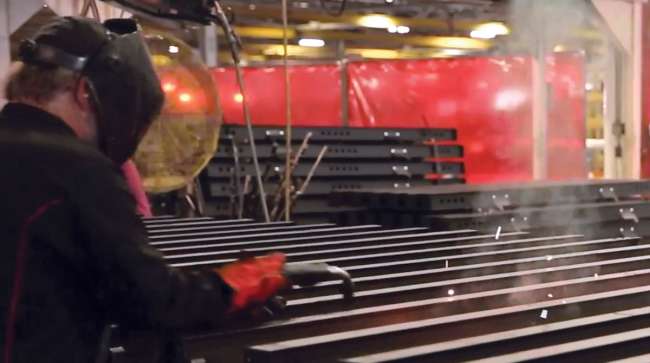Senior Reporter
July US Trailer Orders Hit Lowest Level of 2021, FTR Reports

[Stay on top of transportation news: Get TTNews in your inbox.]
U.S. trailer orders in July slid more, barely clearing 8,000 units and setting a new low point in this cycle, ACT Research reported as a persistent set of limiting conditions remained entrenched.
Fleet demand for dry vans and refrigerated trailers, especially, is largely blocked. Order boards are full for this year. Ongoing supply chain disruptions and labor market issues limit production. The cost of materials and components is rising, leaving trailer makers hesitant about opening up 2022 order boards.
No quick relief is in sight.
Net trailer orders were 8,128 compared with 18,851 a year earlier, according to ACT.

Hammond
The previous low this year was in May when orders were 8,676.
“Our supply chain team continues to stay on top of things, and they have shoe-string catches every day keeping plants running. Every day, they are working to bring components to the plants just in time for production. It’s a very difficult environment,” Chris Hammond, executive vice president of sales at Great Dane, told Transport Topics.
Hammond said Great Dane has not opened its 2022 order board.
Another trailer maker executive echoed those thoughts.

Giesen
“Supply chain issues continue to be a weekly situation to deal with,” said David Giesen, vice president of sales at Stoughton. “We have been fortunate that we have not shut down production to this point.”
Stoughton has not opened its order boards for next year, either, but has filled slots through Q1 with carryover orders that could not be completed this year, he said. “We hope to open Q2 at some point in the near future as we get firmer pricing on components.”
Another once-normal pattern is gone, said Frank Maly, director of commercial vehicle transportation analysis for ACT.
RELATED: Great Dane FleetPulse to become standard feature
“The industry normally tracks in a 1.25 to 1.75 band of trailer orders to tractor orders,” he said. “Seasonality can move the metric around during the year. 2021 started with the ratio a bit above 1.0 and it was there for the entire first quarter. It then slipped below 1.0 in April and has continued to trend downward over the last four months.”

How much impact does driver pay have in hiring drivers? And what else can fleets do to recruit and retain quality talent? Hear a snippet from DriverReach founder and CEO Jeremy Reymer, above, and listen to the full program at RoadSigns.TTNews.com.
Now that relationship is 0.6 trailers per tractor, the lowest point since 2012, he added, “because trailer makers are not accepting orders.”
At the same time, Hammond and Giesen said they would pivot and return to trade shows this year.
Great Dane recently announced its FleetPulse telematics device as standard on vans and refrigerated trailers when it opens up 2022 for new orders, Hammond said, “We will be meeting with fleets to share the benefits of connected trailers.”
Giesen said Stoughton will get back to the normal pattern of participation going forward “as long as there are no changes to the COVID-related rules of engagement.”
FTR pegged orders at 8,200.

Ake
“Right now, unless there’s some [additional] economic disruption, it looks like the industry is in catch-up mode all the way through 2022 and into 2023,” said Don Ake, vice president of commercial vehicles for FTR.
“Trailer makers are fully booked for 2021, can’t make what they booked and they are not taking orders for 2022,” he said. “It is a very stressful, uncertain environment.”
The industry’s smaller heavy-haul segment, however, provides some sense of normalcy, except for facing soaring steel costs, one trailer maker executive said.
“I don’t think anybody is complaining about the level of business. It’s been pretty consistent,” said Greg Smith, vice president of marketing for Fontaine Heavy-Haul.
“Our smallest trailer is 80,000-pound capacity, and we build up to 80-ton trailers, routinely,” he said. “But think about it, when your main ingredient of your product is steel, and steel has done what it has done. I think over the course of the past year it has more than tripled. Obviously, that’s a challenge. Overall, I kind of feel like everything is still a little upbeat.”
Xcalibur by Transport Topics on Scribd
The company recently introduced four new Xcalibur extendable models that are 53-feet in the closed position and 90-feet fully opened. When the trailers are closed and the sliding axles are in their most forward position, the distance between the kingpin and the rear axle center is less than 40 feet, making these trailers legal to operate in California, according to the Springville, Ala.-based company. Fontaine is part of Marmon Holdings Inc., a unit of Berkshire Hathaway Inc.
“It’s really a small adjustment for us on an existing line,” Smith said.
But a timely one.
“This Xcalibur is used for hauling large bridge beams, large pipe and things like that, and as we’re getting into infrastructure [spending], those will be important products to have.”
Earlier, Fontaine came out with its Workhorse 55PVR model, he added.
“It is a low-bed trailer used for hauling paving equipment,” Smith said, “which will be another key aspect as infrastructure takes off.”
Material shortages are still getting worse. The cost is going up regularly. I have never seen the supply chain as disrupted as it is now.
Craig Bennett, vice president of sales for Utility Trailer Manufacturing Co.
In the meantime, another trailer maker executive, whose company has the leading share in the refrigerated trailer market, said there are material shortages and delays daily.
“Manufacturing has to bring trailers that are off the assembly line back into production every day as the missing materials are delivered,” said Craig Bennett, senior vice president of sales at Utility Trailer Manufacturing Co. “Material shortages are still getting worse. The cost is going up regularly. I have never seen the supply chain as disrupted as it is now.”
Bennett said Utility has not started quoting 2022 production yet, “but we are very close to doing that.”
With the COVID uptick, getting enough manpower is challenging again, he said. “We have not been able to increase our manpower for several months.”
Want more news? Listen to today's daily briefing below or go here for more info:





